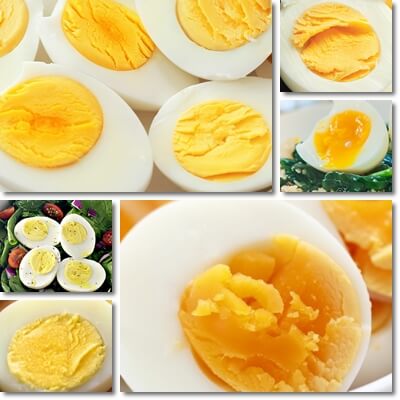Boiled eggs may not be everyone’s first choice when it comes to eating eggs, but they are healthy and better for you than eggs cooked differently for a number of reasons.
But however healthy, boiled eggs are not going to make the cut if you don’t know what to eat them with so they taste at least as good as they are healthy. So what do you eat with boiled eggs so they taste good, but stay healthy?
1) Boiled eggs with mini mozzarellas, cherry tomatoes and avocado – for a light meal
If what you’re looking for is a light meal that is also nutritious and satiating, try chopped hard boiled eggs with mini mozzarella balls, cherry tomato halves and chopped avocado. Just a fresh salad that is not the least bit heavy of the stomach, but gets you the protein, fat and carbs you need to feel satiated without feeling full and lots of B vitamins, vitamin A, vitamin D and minerals.

If you have acid reflux disease and can’t eat tomatoes, you can substitute the cherry tomatoes with ripe beefsteak tomatoes which are lower-acidity and kinder on the stomach, or go for options that are not acidic at all such as boiled sweet corn or roasted sweet potatoes.
2) Boiled eggs with mashed avocado on whole grain toast – for more energy and vitality
Avocado toast is a classic favorite, but paired with boiled eggs, it becomes a powerhouse of nutrition with impressive anti-anemia effects and benefits for energy metabolism.
Boiled eggs are naturally high in iron, vitamin B12 and vitamin B9 which are needed to make red blood cells to transport oxygen to organs and tissues for elevated energy levels and a boost in vitality.
See more benefits of boiled eggs.
Avocado also provides high amounts of vitamin B9, but also vitamin B6 which helps produce hemoglobin in red blood cells and boosts the capacity of hemoglobin to absorb oxygen for added benefits for tiredness and fatigue. Add a whole grain toast for a boost in complex carbohydrates that release energy slowly over the course of several hours and you have yourself a perfect meal for more energy.

3) Boiled eggs, avocado and potato salad – for high blood pressure
A boiled egg, avocado and potato salad is one of the simplest and healthiest meals you can eat for high blood pressure. Avocado together with potatoes provide around 20% of the total daily requirements of potassium for the average adult which is a lot! Potassium is an electrolyte needed to lower blood pressure numbers that are too high – it works by inducing relaxation of blood vessel walls to release pressure.
As for the boiled eggs, they represent primarily the protein part of the meal, and constitute a compatible base for avocado and potatoes.
Not just this, but the high content of protein in boiled eggs serves to create connective tissue such as elastin and collagen which contribute to blood vessel wall makeup and elasticity, playing an indirect role in blood pressure management.
Do consider a tablespoon of raw extravirgin olive oil as dressing instead of mayo to add Omega-3 and other healthy unsaturated fatty acids with anti-inflammatory benefits for the cardiovascular system. And if you cut the hard boiled potatoes in smaller pieces and shuffle them around, part of the yolk will break apart and create a creamy dressing that tastes amazing topped with lots of fresh chopped parsley.
4) Boiled eggs with sweet potato, arugula, yellow and orange cherry tomatoes – for good eyesight
Boiled eggs pair well with sweet potatoes, tomatoes and salad greens. And if you choose the right colors, you get a boost in benefits for eyesight. You have hard boiled eggs whose yellow-orange yolk is rich in retinol, or preformed vitamin A, which holds benefits for visual acuity, color vision and dim light vision (or night vision).
Sweet potatoes with orange flesh are an extreme source of carotenoids, orange pigmented antioxidants with vitamin A activity – just 100 grams of sweet potato provides the equivalent of 120% of the entire daily requirements of vitamin A for an adult. Whereas a serving of 100 grams of boiled eggs, roughly two small to medium-sized chicken eggs, will get you close to 20% of daily vitamin A values.
Pair with lots of arugula whose rich green leaves are packed with carotenoid antioxidants with vitamin A activity, not to mention healthy dietary fiber, vitamins C and K with anti-inflammatory benefits and vitamin B9 and iron for a boost in vitality and energy levels.
Build on the flavor profile with orange and yellow tomatoes, cherry, plum or regular, rich in lutein and zeaxanthin antioxidants without vitamin A activity, but with scientifically proven benefits for eyesight such as lower risks of cataract and age related macular degeneration (loss of central vision due to old age).
5) Boiled eggs with escarole endive, radish and yellow and red bell peppers – for anti-inflammatory benefits
Pair your boiled eggs with escarole, or broad-leaved endive, radishes and yellow and red bell peppers for a range of anti-inflammatory benefits.
The amino acids that make up the protein in egg yolk repair muscle, skin, bones and nerve tissue, exerting reparative and healing effects that counteract inflammation. See more benefits of eating egg yolk.
Escarole, also known as broad-leaved endive, is one of many different types of chicory greens or endives, and a popular salad green. Escarole is high in vitamin K: with over two times the daily values for vitamin K per 100 grams, escarole is a source of impressive anti-inflammatory benefits.
Radishes have scientifically proven detoxifying effects, anti-inflammatory and anticancer activity. You can choose between red or pink radishes and seasonal white winter radishes or black radish for anti-inflammatory benefits.
Yellow and red bell peppers are an accessible food with great flavor that also provides good amounts of vitamin C. Studies reveal vitamin C lowers inflammation markers in the body and induces healing.
6) Boiled eggs with cucumber, zucchini, mixed salad greens – for a low calorie meal
If you are looking to lose weight, then eating fewer calories is the way to go. A good option for a meal packed with nutrition, but very low in calories is boiled eggs with cucumber, zucchini and mixed salad greens. You get 155 kcal (kilocalories, calories) from 100 grams of hard boiled chicken eggs, or two small to medium-sized chicken eggs.
Mixed salad greens have, on average, only 20-25 kcal per 100 grams (or less). Consider lamb’s lettuce, arugula, baby spinach, green lettuce, escarole or broad-leaved endive, or curly endive. Cucumber and zucchini both have just 16 kcal per 100 grams.
A meal consisting of two hard boiled eggs, around 150 grams of raw cucumber, 150 grams of raw zucchini (thinly sliced) and 200 grams of mixed salad greens will only get you about 210 kcal (kilocalories). If you throw in 200 grams of cherry tomatoes, that adds up to only 250 kcal total. To keep the meal low in calories, dress the salad with two tablespoons of lemon juice.
7) Boiled eggs with canned tuna and chickpeas, celery stalks and cherry tomatoes – for a high protein meal
You get protein from three different types of foods: eggs, fish and legumes. Two boiled eggs will get you close to 13 grams of protein, complete in all amino acids. Just 100 grams of tuna will get you at least 22 grams of protein, also complete in all amino acids.
Find out more about tuna nutrition. A serving of 70 grams of cooked chickpeas (canned included) will add another 6 grams of protein to the meal.
This brings the total protein content of your meal to 41 grams, just 9 grams shy of the daily recommended intake of protein for an adult. But to balance out the meal, even if just a little, add fresh stalk celery and sweet and acidic cherry tomatoes to your meal, and top with fresh parsley.
8) Boiled egg with grilled chicken breast, feta cheese crumbles and pumpkin seeds, red onion, avocado, baby spinach – another option for a meal packed with protein
The meal idea provides protein from eggs, chicken meat and feta cheese, and some from pumpkin seeds, for a balanced intake of amino acids. Two boiled eggs will get you close to 13 grams of protein, complete in all amino acids. Just 150 grams of chicken breast, boneless and skinless (weighed raw), will get you about 34 grams of protein, also complete in all amino acids.
A serving of 50 grams of feta cheese will add another 7 grams of protein to the meal, while just 15 grams of raw pumpkin seeds 4.5 grams. This brings the total protein content of your meal to 58.5 grams, 8.5 more grams of protein than the daily recommended intake for an adult.
But to balance out the meal, even if just a little, add raw red onion, avocado and baby spinach to your meal. You can also switch up the flavor profile with roasted broccoli or grilled zucchini.
